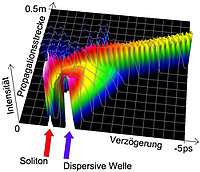The generation of white light from spectrally narrow band laser radiation is one of the most fascinating processes in nonlinear optics. This mechanism has found wide variety of uses in spectroscopy, metrology, and medical imaging. At comparatively low light outputs, light sources based on optical fibers offer excellent spatial coherence properties and a small radiation area. White light radiation sources can therefore achieve a spectral radiance that makes them millions of times brighter than the sun.
The spectral coherence properties of such radiation sources, however, are comparatively modest. This means that while the light of the white light source can be well focused on a very small area, it is impossible to time the concentration of the pulse energy over a small time interval. In the current issue of the journal Physical Review Letters [PRL 110, 233901 (2013)] Ayhan Demircan ask, Shalva Amiranashvili, Carsten Brée and Günter Steinmeyer, a new solution to get around this fundamental problem of laser and white light sources. This proposal provides for using two light pulses at different wavelengths for white light generation in an optical fiber. For this one must choose the wavelengths of the pulses so that they propagate with nearly the same speed in the fiber. Similar to a surfer who measures a wave, the two pulses can then undergo a long-lasting bond that leads to an intense nonlinear interaction. This interaction quickly fills the spectral gap between the two pulses with coherently generated new spectral components.
